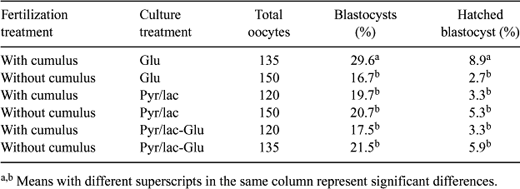248 EMBRYO DEVELOPMENT IN MICRODROPS AND MICROCHANNELS: COMPARISON OF NCSU23 SEQUENTIAL AND NON-SEQUENTIAL CULTURE MEDIUM
A.S. Lima A , C.E. Ferguson A and M.B. Wheeler A BA Department of Animal Sciences University of Illinois at Urbana-Champaign
B Beckman Institute for Advanced Science and Technology, University of Illinois at Urbana-Champaign, Urbana, IL 61801, USA. Email: cefergus@uiuc.edu
Reproduction, Fertility and Development 17(2) 274-275 https://doi.org/10.1071/RDv17n2Ab248
Submitted: 1 August 2004 Accepted: 1 October 2004 Published: 1 January 2005
Abstract
The in vitro culture systems used to produce pig embryos generally result in few embryos developing to the blastocyst stage. The use of pyruvate (pyr) and lactate (lac) during the culture of zygotes to the 8-cell stage followed by glucose (glu) supplementation replacing pyr and lac appears to be beneficial for embryo development in the pig. The aim of this study was to compare the embryo development rates from pig oocytes fertilized with and without cumulus cells in 100-μL microdrops (MD) and cultured in 100-μL MD or microchannels (MC), using NCSU23 containing 8 mg/mL of BSA and supplemented with (1) glu or (2) pyr/lac or (3) pyr/lac for the first three days and then with just glu for the remainder of culture period (pyr/lac-glu). Sow oocytes were matured in TCM199 supplemented with gonadotropins for the first 22 h, and for an additional 22 h without hormones. After 44 h of maturation, oocytes were placed in MD of modified tris-buffered medium to be fertilized using 3 × 105 sperm/mL. Oocytes were divided into two groups for fertilization: with and without cumulus cells. Following 6 h of fertilization, all inseminated oocytes were washed, divided into groups of 15, allotted to the three culture media treatment groups as described above, and incubated in either MD or MC. With the exception of one treatment there were no significant differences in development rates among embryos cultured in MD or MC, hence data were pooled from these two culture devices. Only oocytes fertilized without cumulus cells and cultured in pyr/lac in MC appeared to have lower rates of blastocyst formation (11.67%) than those cultured in MD (26.67%) in the same culture medium. When the six treatments were compared, oocytes fertilized with cumulus cells and cultured in glu had significantly higher (P < 0.05) blastocyst rates and hatching rates compared with the other treatments, with the exception of those fertilized without cumulus cells and cultured in pyr/lac-glu. There were no significant differences among other treatments in Day 7 blastocyst or in Day 9 hatching rates. In conclusion, both culture devices can be used to reach similar blastocyst rates with different treatments. In this experiment, the removal of cumulus cells before fertilization appeared to enhance embryo development in vitro when sequential media are used. On the other hand, the presence of cumulus cells before fertilization seems to enhance embryo development when non-sequential glu medium is used.

|


